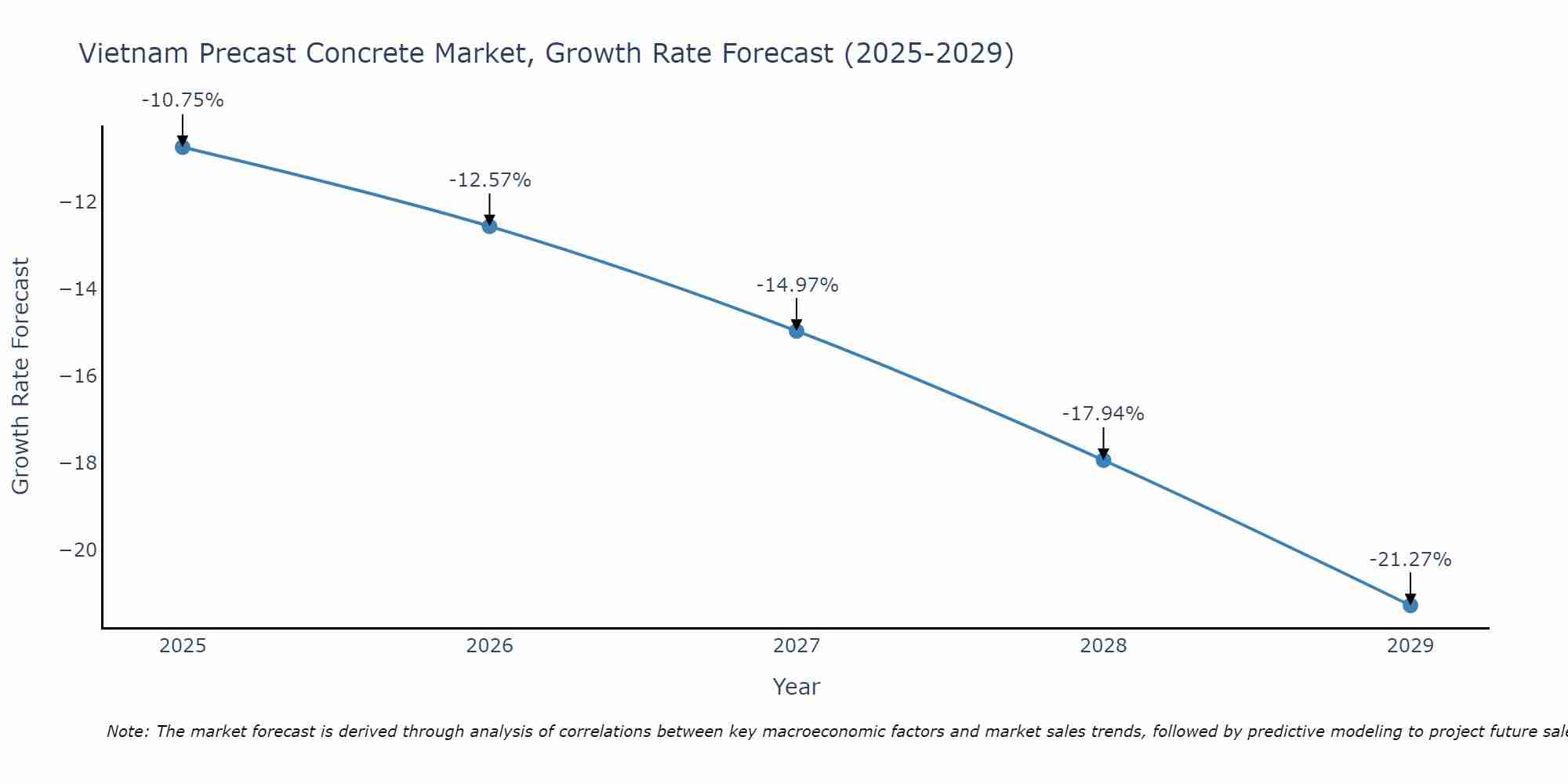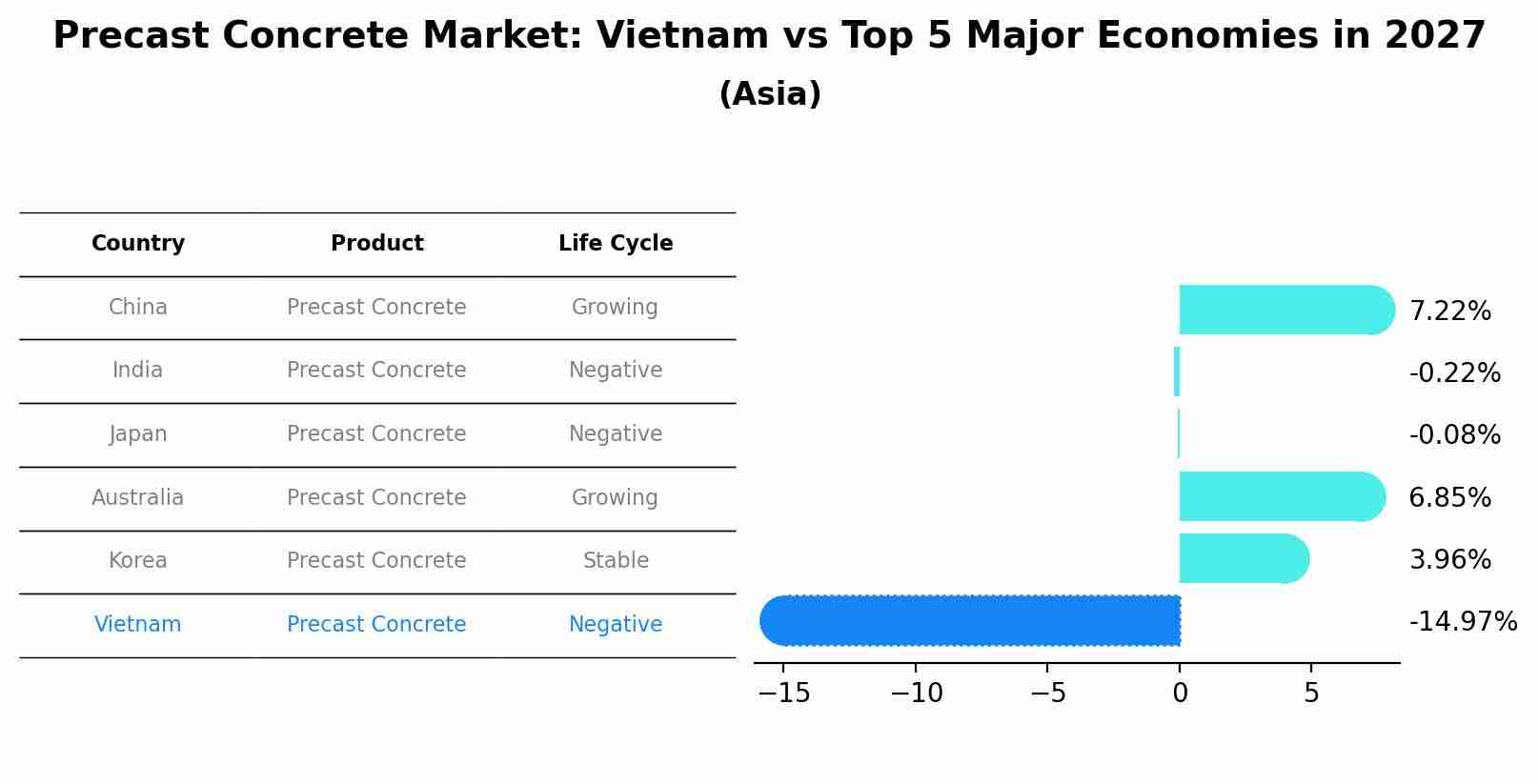Vietnam Precast Concrete Market (2025-2031) Outlook | Trends, Analysis, Share, Value, Growth, Companies, Industry, Forecast, Revenue & Size
| Product Code: ETC372870 | Publication Date: Aug 2022 | Updated Date: Apr 2025 | Product Type: Market Research Report | |
| Publisher: 6Wresearch | Author: Ravi Bhandari | No. of Pages: 75 | No. of Figures: 35 | No. of Tables: 20 |
Vietnam Precast Concrete Market Size Growth Rate
The Vietnam Precast Concrete Market could see a tapering of growth rates over 2025 to 2029. Starting high at -10.75% in 2025, the market steadily declines to -21.27% by 2029.

Precast Concrete Market: Vietnam vs Top 5 Major Economies in 2027 (Asia)
By 2027, the Precast Concrete market in Vietnam is anticipated to reach a growth rate of -14.97%, as part of an increasingly competitive Asia region, where China remains at the forefront, supported by India, Japan, Australia and South Korea, driving innovations and market adoption across sectors.

Vietnam Precast Concrete Market Synopsis
The precast concrete market in Vietnam has been steadily expanding, largely propelled by the country`s booming construction industry. Precast concrete offers several advantages, including cost-effectiveness, speed of construction, and enhanced quality control. It is widely used in the construction of residential buildings, infrastructure projects, and commercial structures. The government`s focus on infrastructure development and the need for affordable housing have driven demand for precast concrete products. Additionally, sustainability concerns have led to the adoption of precast concrete as an eco-friendly construction option.
Drivers of the Market
The Vietnam precast concrete market is witnessing robust growth due to several key drivers. Firstly, rapid urbanization and infrastructure development projects across the country are propelling the demand for precast concrete components in construction. Precast concrete`s efficiency and cost-effectiveness in large-scale projects make it a preferred choice. Moreover, its durability and resistance to natural disasters, such as typhoons and floods, make it crucial for Vietnam climatic conditions. Government initiatives to promote sustainable construction methods also contribute to market growth, as precast concrete is more environmentally friendly than traditional construction. Additionally, the increasing adoption of modern architectural designs and the need for quicker construction turnaround times are further driving the demand for precast concrete in Vietnam construction sector.
Challenges of the Market
The Vietnam precast concrete market confronts challenges related to quality control and transportation logistics. Maintaining consistent quality across precast concrete components is crucial for construction projects` structural integrity. This requires strict quality control processes and skilled labor, which can be challenging to manage. Moreover, precast concrete elements are heavy and bulky, making transportation and logistics a logistical hurdle, especially for projects located in remote or congested areas.
COVID-19 Impact on the Market
The Vietnam precast concrete market was impacted by COVID-19 due to construction project delays and labor shortages. Supply chain disruptions and reduced construction activity led to a slowdown in the market. However, the government`s infrastructure investments provided some support to the industry.
Key Players in the Market
The precast concrete market in Vietnam is characterized by a mix of local and international players. A key player in this market is VME Precast, a subsidiary of Vinaconex, which specializes in manufacturing precast concrete components for various construction projects. Additionally, BCI Vietnam is recognized for its expertise in providing precast concrete solutions for infrastructure and building construction.
Key Highlights of the Report:
- Vietnam Precast Concrete Market Outlook
- Market Size of Vietnam Precast Concrete Market, 2024
- Forecast of Vietnam Precast Concrete Market, 2031
- Historical Data and Forecast of Vietnam Precast Concrete Revenues & Volume for the Period 2021-2031
- Vietnam Precast Concrete Market Trend Evolution
- Vietnam Precast Concrete Market Drivers and Challenges
- Vietnam Precast Concrete Price Trends
- Vietnam Precast Concrete Porter's Five Forces
- Vietnam Precast Concrete Industry Life Cycle
- Historical Data and Forecast of Vietnam Precast Concrete Market Revenues & Volume By Product for the Period 2021-2031
- Historical Data and Forecast of Vietnam Precast Concrete Market Revenues & Volume By Structural Building Components for the Period 2021-2031
- Historical Data and Forecast of Vietnam Precast Concrete Market Revenues & Volume By Architectural Building Components for the Period 2021-2031
- Historical Data and Forecast of Vietnam Precast Concrete Market Revenues & Volume By Transportation Products for the Period 2021-2031
- Historical Data and Forecast of Vietnam Precast Concrete Market Revenues & Volume By Water & Waste Handling Products for the Period 2021-2031
- Historical Data and Forecast of Vietnam Precast Concrete Market Revenues & Volume By Others for the Period 2021-2031
- Historical Data and Forecast of Vietnam Precast Concrete Market Revenues & Volume By End-use for the Period 2021-2031
- Historical Data and Forecast of Vietnam Precast Concrete Market Revenues & Volume By Residential for the Period 2021-2031
- Historical Data and Forecast of Vietnam Precast Concrete Market Revenues & Volume By Non-residential for the Period 2021-2031
- Historical Data and Forecast of Vietnam Precast Concrete Market Revenues & Volume By Infrastructure for the Period 2021-2031
- Vietnam Precast Concrete Import Export Trade Statistics
- Market Opportunity Assessment By Product
- Market Opportunity Assessment By End-use
- Vietnam Precast Concrete Top Companies Market Share
- Vietnam Precast Concrete Competitive Benchmarking By Technical and Operational Parameters
- Vietnam Precast Concrete Company Profiles
- Vietnam Precast Concrete Key Strategic Recommendations
Frequently Asked Questions About the Market Study (FAQs):
- Single User License$ 1,995
- Department License$ 2,400
- Site License$ 3,120
- Global License$ 3,795
Search
Thought Leadership and Analyst Meet
Our Clients
Related Reports
- Canada Oil and Gas Market (2026-2032) | Share, Segmentation, Value, Industry, Trends, Forecast, Analysis, Size & Revenue, Growth, Competitive Landscape, Outlook, Companies
- Germany Breakfast Food Market (2026-2032) | Industry, Share, Growth, Size, Companies, Value, Analysis, Revenue, Trends, Forecast & Outlook
- Australia Briquette Market (2025-2031) | Growth, Size, Revenue, Forecast, Analysis, Trends, Value, Share, Industry & Companies
- Vietnam System Integrator Market (2025-2031) | Size, Companies, Analysis, Industry, Value, Forecast, Growth, Trends, Revenue & Share
- ASEAN and Thailand Brain Health Supplements Market (2025-2031) | Strategy, Consumer Insights, Analysis, Investment Trends, Opportunities, Growth, Size, Share, Industry, Revenue, Segments, Value, Segmentation, Supply, Forecast, Restraints, Outlook, Competition, Drivers, Trends, Demand, Pricing Analysis, Competitive, Strategic Insights, Companies, Challenges
- ASEAN Bearings Market (2025-2031) | Strategy, Consumer Insights, Analysis, Investment Trends, Opportunities, Growth, Size, Share, Industry, Revenue, Segments, Value, Segmentation, Supply, Forecast, Restraints, Outlook, Competition, Drivers, Trends, Demand, Pricing Analysis, Competitive, Strategic Insights, Companies, Challenges
- Europe Flooring Market (2025-2031) | Outlook, Share, Industry, Trends, Forecast, Companies, Revenue, Size, Analysis, Growth & Value
- Saudi Arabia Manlift Market (2025-2031) | Outlook, Size, Growth, Trends, Companies, Industry, Revenue, Value, Share, Forecast & Analysis
- Uganda Excavator, Crane, and Wheel Loaders Market (2025-2031) | Strategy, Consumer Insights, Analysis, Investment Trends, Opportunities, Growth, Size, Share, Industry, Revenue, Segments, Value, Segmentation, Supply, Forecast, Restraints, Outlook, Competition, Drivers, Trends, Demand, Pricing Analysis, Competitive, Strategic Insights, Companies, Challenges
- Rwanda Excavator, Crane, and Wheel Loaders Market (2025-2031) | Strategy, Consumer Insights, Analysis, Investment Trends, Opportunities, Growth, Size, Share, Industry, Revenue, Segments, Value, Segmentation, Supply, Forecast, Restraints, Outlook, Competition, Drivers, Trends, Demand, Pricing Analysis, Competitive, Strategic Insights, Companies, Challenges
Industry Events and Analyst Meet
Whitepaper
- Middle East & Africa Commercial Security Market Click here to view more.
- Middle East & Africa Fire Safety Systems & Equipment Market Click here to view more.
- GCC Drone Market Click here to view more.
- Middle East Lighting Fixture Market Click here to view more.
- GCC Physical & Perimeter Security Market Click here to view more.
6WResearch In News
- Doha a strategic location for EV manufacturing hub: IPA Qatar
- Demand for luxury TVs surging in the GCC, says Samsung
- Empowering Growth: The Thriving Journey of Bangladesh’s Cable Industry
- Demand for luxury TVs surging in the GCC, says Samsung
- Video call with a traditional healer? Once unthinkable, it’s now common in South Africa
- Intelligent Buildings To Smooth GCC’s Path To Net Zero


















